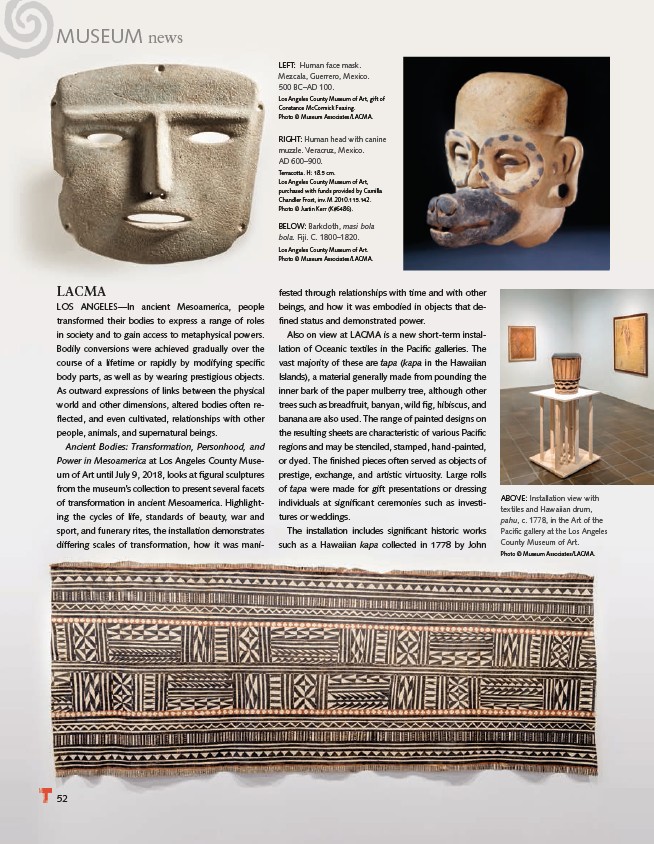
MUSEUM news
LACMA
LOS ANGELES—In ancient Mesoamerica, people
transformed their bodies to express a range of roles
in society and to gain access to metaphysical powers.
Bodily conversions were achieved gradually over the
course of a lifetime or rapidly by modifying specifi c
body parts, as well as by wearing prestigious objects.
As outward expressions of links between the physical
world and other dimensions, altered bodies often refl
ected, and even cultivated, relationships with other
people, animals, and supernatural beings.
Ancient Bodies: Transformation, Personhood, and
Power in Mesoamerica at Los Angeles County Museum
52
of Art until July 9, 2018, looks at fi gural sculptures
from the museum’s collection to present several facets
of transformation in ancient Mesoamerica. Highlighting
the cycles of life, standards of beauty, war and
sport, and funerary rites, the installation demonstrates
differing scales of transformation, how it was manifested
LEFT: Human face mask.
Mezcala, Guerrero, Mexico.
500 BC–AD 100.
Los Angeles County Museum of Art, gift of
Constance McCormick Fearing.
Photo © Museum Associates/LACMA.
RIGHT: Human head with canine
muzzle. Veracruz, Mexico.
AD 600–900.
Terracotta. H: 18.5 cm.
Los Angeles County Museum of Art,
purchased with funds provided by Camilla
Chandler Frost, inv. M.2010.115.142.
Photo © Justin Kerr (K#6486).
BELOW: Barkcloth, masi bola
bola. Fiji. C. 1800–1820.
Los Angeles County Museum of Art.
Photo © Museum Associates/LACMA.
through relationships with time and with other
beings, and how it was embodied in objects that defi
ned status and demonstrated power.
Also on view at LACMA is a new short-term installation
of Oceanic textiles in the Pacifi c galleries. The
vast majority of these are tapa (kapa in the Hawaiian
Islands), a material generally made from pounding the
inner bark of the paper mulberry tree, although other
trees such as breadfruit, banyan, wild fi g, hibiscus, and
banana are also used. The range of painted designs on
the resulting sheets are characteristic of various Pacifi c
regions and may be stenciled, stamped, hand-painted,
or dyed. The fi nished pieces often served as objects of
prestige, exchange, and artistic virtuosity. Large rolls
of tapa were made for gift presentations or dressing
individuals at signifi cant ceremonies such as investitures
or weddings.
The installation includes signifi cant historic works
such as a Hawaiian kapa collected in 1778 by John
ABOVE: Installation view with
textiles and Hawaiian drum,
pahu, c. 1778, in the Art of the
Pacifi c gallery at the Los Angeles
County Museum of Art.
Photo © Museum Associates/LACMA.